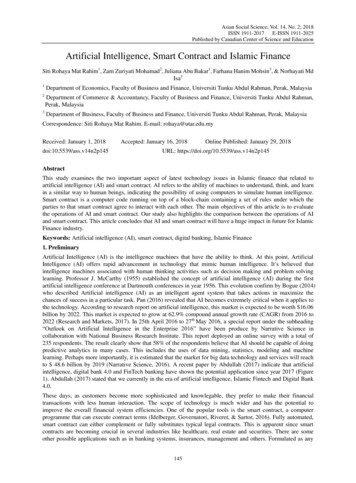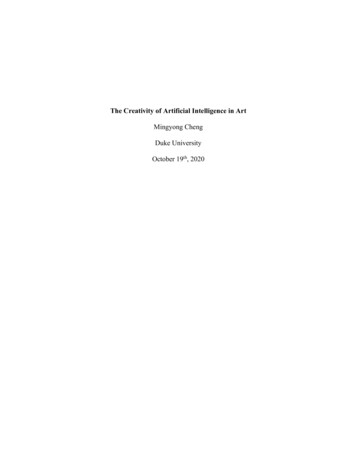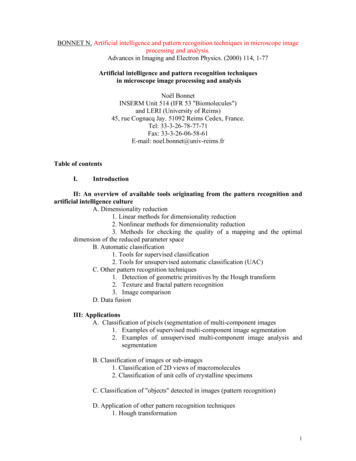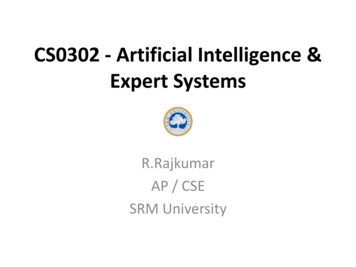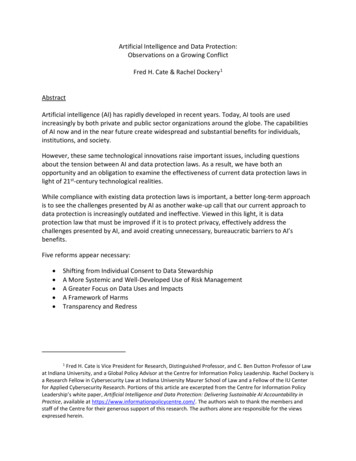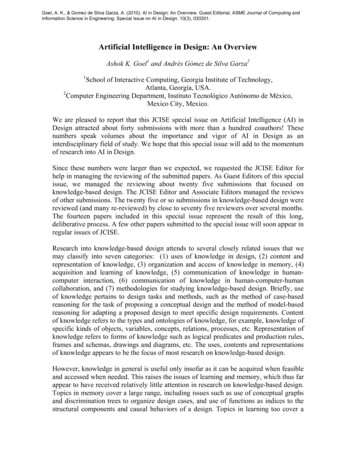
Transcription
Goel, A. K., & Gomez de Silva Garza, A. (2010). AI in Design: An Overview. Guest Editorial, ASME Journal of Computing andInformation Science in Engineering: Special Issue on AI in Design. 10(3), 030301.Artificial Intelligence in Design: An OverviewAshok K. Goel1 and Andrés Gómez de Silva Garza21School of Interactive Computing, Georgia Institute of Technology,Atlanta, Georgia, USA.2Computer Engineering Department, Instituto Tecnológico Autónomo de México,Mexico City, Mexico.We are pleased to report that this JCISE special issue on Artificial Intelligence (AI) inDesign attracted about forty submissions with more than a hundred coauthors! Thesenumbers speak volumes about the importance and vigor of AI in Design as aninterdisciplinary field of study. We hope that this special issue will add to the momentumof research into AI in Design.Since these numbers were larger than we expected, we requested the JCISE Editor forhelp in managing the reviewing of the submitted papers. As Guest Editors of this specialissue, we managed the reviewing about twenty five submissions that focused onknowledge-based design. The JCISE Editor and Associate Editors managed the reviewsof other submissions. The twenty five or so submissions in knowledge-based design werereviewed (and many re-reviewed) by close to seventy five reviewers over several months.The fourteen papers included in this special issue represent the result of this long,deliberative process. A few other papers submitted to the special issue will soon appear inregular issues of JCISE.Research into knowledge-based design attends to several closely related issues that wemay classify into seven categories: (1) uses of knowledge in design, (2) content andrepresentation of knowledge, (3) organization and access of knowledge in memory, (4)acquisition and learning of knowledge, (5) communication of knowledge in humancomputer interaction, (6) communication of knowledge in human-computer-humancollaboration, and (7) methodologies for studying knowledge-based design. Briefly, useof knowledge pertains to design tasks and methods, such as the method of case-basedreasoning for the task of proposing a conceptual design and the method of model-basedreasoning for adapting a proposed design to meet specific design requirements. Contentof knowledge refers to the types and ontologies of knowledge, for example, knowledge ofspecific kinds of objects, variables, concepts, relations, processes, etc. Representation ofknowledge refers to forms of knowledge such as logical predicates and production rules,frames and schemas, drawings and diagrams, etc. The uses, contents and representationsof knowledge appears to be the focus of most research on knowledge-based design.However, knowledge in general is useful only insofar as it can be acquired when feasibleand accessed when needed. This raises the issues of learning and memory, which thus farappear to have received relatively little attention in research on knowledge-based design.Topics in memory cover a large range, including issues such as use of conceptual graphsand discrimination trees to organize design cases, and use of functions as indices to thestructural components and causal behaviors of a design. Topics in learning too cover a
vast landscape, including issues such as learning of functional indices to design cases,learning of design patterns and principles from design cases, and learning of functionalmodels of designs from their drawings.Design of course is situated in an external world. In modern design, designers in generalgenerate designs through interaction with computers on one hand, and in collaborationwith other designers on the other. Collaboration among designers in contemporary desgnagain is mediated through computers. This raises the issue of communication of designknowledge in human-computer interaction, for example, through diagrams, designmodels, and virtual and augmented reality. It also raises the issue of communication inhuman-computer-human collaboration, for example, through design repositories, designmodels, and design rationale. Research into knowledge-based design has sought toaddress both kinds of design communication.Finally, research on knowledge-based design addresses methodological issues such as theempirical basis and epistemological foundations of design theories, and measures andmetrics for evaluating design techniques and decisions. Methodological topics inknowledge-based design include set- and graph-theoretic characterization of classes ofdesign problems, axiomatization of design knowledge, protocol and in situ studies ofdesigners, and construction of standardized datasets for evaluating the efficacy of designmethods.Papers in this Special IssueTen of the fourteen papers in this special issue can be classified into three maincategories: (i) functional decompositions of designs, (2) evolutionary computing indesign, and (3) communication of design knowledge. Since function is a core idea inengineering design [1,2], functional representations and their use in design have receivedsubstantial attention in research into knowledge-based design. One class of functionalmodels emphasizes behavior as an intermediate abstraction between function andstructure, e.g. [3-8]. Following [1], four papers in this special issue focus on another classof functional representations that emphaize functional decomposition. In “FunctionSemantic Representation (FSR): A Rule-Based Ontology for Product Functions,” Yang,Patil & Dutta present a rule-based ontological formalism for capturing functionaldescriptions of designs in order to more easily capture, exchange, and reuse them. In “AConstraint-Based Approach to the Composition Relation Management of a Product Classin Design,” Yvars presents a constraint-satisfaction technique that takes into accountstructural and functional relationships in a product model for use in product dimensioningand configuring. In “Topological Information Content and Expressiveness of FunctionModels in Mechanical Design,” Sen, Summers & Mocko deveop representations andmetrics for analyzing the information content of function flow models of designs.Finally, in “Thesaurus for Natural-Language-Based Conceptual Design,” Yamamoto,Taura, Ohashi & Yamamoto present a thesaurus based on semi-automatic extraction ofthe hierarchical structure of words from natural language sentences. They also show howthe thesaurus can be used to simplify the process of functional decomposition inconceptual design.
Design in general is evolutionary in that new designs typically are generated not fromscratch but by adapting and combining known designs. The evolutionary process ofdesign has led many researchers in AI in design to explore methods of evolutionarycomputing, such as genetic algorithms and genetic programming, for evolvingengineering designs, e.g., [9-11]. In knowledge-based design, the focus of this line ofresearch typically has been on using domain knowledge to guide and constrain theevolutionary process. In “A System Framework with On-line Monitoring and Evaluationfor Design Evolution of Engineering Systems,” Gamage & de Silva describe a method forevolving engineering systems that uses bond graphs to represent designs and geneticprogramming to explore the design space autonomously. In “Case-Based Reasoning forEvolutionary MEMS Design,” Cobb & Agogino present a case-based approach toproviding a multi-objective genetic algorithm for synthesizing designs of Micro-ElectroMechanical Systems.As we briefly mentioned above, research on knowledge-based design includescommunication of knowledge in human-computer-human collaboration. Construction ofdesign repositories using multimodal knowledge representations is one powerfultechnique for communicating design knowledge, e.g., [12-19]. In “In Search of DesignInspiration: A Semantic-Based Approach,” Setchi & Bouchard describe the use ofdomain-specific ontologies for semantic-based retrieval of design images. In “ImpactingDesigner Creativity Through IT-Enabled Concept Generation,” English, Maim, Lewis,Schmidt, Viswanathan, Linsey, McAdams, Bishop, Campbell, Poppa, Stone & Orsborndescribe design support tools for design repositories and concept generation.Capture, storage and access of design rationale is another powerful technique forcommunication of design knowledge in human-computer-human collaboration, e.g., [2024]. In “A Semantic Information Model for Capturing and Communicating DesignDecisions,” Rockwell, Grosse, Krishnamurty & Wileden describe the use of the WebOntology Language (OWL) for representing and reusing design rationale. In “A NewDesign Rationale Representation Model for Rationale Mining,” Liang, Liu, Kwong &Lee present a structured representation of design rationale that enhances automaticextraction of the rationale through data mining and knowledge discovery.The last four papers in this special issue signify the large and varied landscape ofknowledge-based design. In “Hybrid Association Mining and Refinement for AffectiveMapping in Emotional Design,” Zhou, Jiao, Schaefer & Chen present a computationaltechnique that combines association mining and refinement to map customer needs intodesign elements. In “Ontology-Based Multi-Platform Identification Method,” Li, Chiang,Terpenny & Gilbert describe an ontology-based method to lower costs and cycle timeswhen combining knowledge across design platforms in mass production scenarios. In“Transformation Design Theory: An Overview,” Weaver, Wood & Jensen provideheuristics for transformation processes that take products or systems from one state toanother in order to maximize their benefit and minimize trade-offs between conflictingneeds. Finally, in “An Integrated Model of Designing,” Srinivasan & Chakrabarti present
a general model of design that integrates product- and process-related aspects of designbased on protocol studies of designers in action.Acknowledgements: We are grateful to the more than one hundred authors of the aboutforty papers submitted to the AI in Design special issue. We are especially grateful to thenearly seventy five anonymous reviewers of the about twenty five papers on knowledgebased design. We thank several Associate Editors of JCISE - Anath Fischer, ChrisGeiger, Ian Grosse, Satyandra Gupta, Kincho Law, Sara McMains, John Michopoulos,Xiaoping Qian, and Kazuhiro Saitou – for their help in reviewing papers submitted to thespecial issue. Finally, we thank Jami J. Shah, the Editor-in-Chief of JCISE for his help,support and encourgement for this special issue.References:[1] Pahl, G., & Beitz. W. (1996) Engineering Design: A Systematic Approach. Englishedition edited by K. Wallace. 2nd Edition. Springer.[2] French, M. (1999) Conceptual Design for Engineers. 3rd Edition. Spinger-Verlag.[3] Chandrasekaran, B. (1994) Functional Representations and Causal Processes. In M.Yovits (editor): Advances in Computers, 22: 73-143, New York: Academic Press.[4] Gero, J., & Kannengiesser, U. (2004). The Situated Function-Behavior-StructureFramework. Design Studies, 25(4): 373-391.[5] Goel, A., Rugaber, S., & Vattam, S. (2009). Structure, Behavior & Function ofComplex Systems: The SBF Modeling Language. Artificial Intelligence forEngineering Design, Analysis and Manufacturing, 23: 23-35.[6] Kitamura, Y., Kashiwase, M., Fuse, M., & Mizoguchi, R. (2004). Deployment of anOntological Framework for Functional Design Knowledge. Advanced EngineeringInformatics, 18(2): 115-127.[7] Prabhakar, S., & Goel, A. (1998). Functional modeling for enabling adaptive designof devices for new environments. Artificial Intelligence for Engineering, 12: 417444.[8] Umeda, Y. & Tomiyama, T. (1997) Functional Reasoning in Design, IEEE Expert,12(2):42-48.[9] Bentley, P. (editor, 1999) Evolutionary Design by Computers. Morgan Kauffman.[10] Eby, D., Averill, R., Punch, W., & Goodman, E. (1999) Optimal Design ofFlywheels Using an Injection Island Genetic Algorithm. Artificial Intelligence forEngineering Design, Analysis and Manufacturing, 13:327-340.[11] Gómez de Silva Garza, A., & Zamora Lores, A. (2008) An Evolutionary ProcessModel for Design Style Imitation. In Proc. Third International Conference onDesign Computing and Cognition (DCC '08), Atlanta, June 2008, Gero & Goel(eds.), pp. 417-436. Springer Verlag. June 2008.[12] Barber, J., Bhatta, S., Goel, A., Jacobson, M., Pearce, M., Penberthy, L., Shankar,M., Simpson, R., & Stroulia, E, (1992) AskJef: integration of case-based andmultimedia technologies for interface design support. In Proc. Second InternationalConference on Artificial Intelligence in Design (AID’92), J. Gero (ed.), Kluwer, pp.457–474.[13] Gebhardt, F, Voß, A, Gräther, W and Schmidt-Belz, B. (1997) Reasoning withComplex Cases. Norwell, MA: Kluwer.
[14] Kolodner, J. (1993). Case-Based Reasoning. San Francisco, Calif.: MorganKaufmann.[15] Maher, M., Balachandran, M., & Zhang, D. (1995) Case-based reasoning in design.Lawrence Erlbaum.[16] Maher, M. L., & Pu, P. (1997). Issues and applications of case-based reasoning indesign. Mahwah, NJ: Lawrence Erlbaum Associates.[17] Murdock, J., Sykman, S., Sriram, R. (1997) An Information Modeling Framework toSupport Design Databases and Repositories. In Proc. 1997 ASME DesignEngineering Technical Conferences (DTEC’ 97), Sacramento, California.[18] Pearce, M, Goel, A, Kolodner, J, Zimring, C, Sentosa, L., Billington, R. (1992)Case-based decision support: a case study in architectural design. IEEE Expert 7(5),14–20.[19] Szykman, S., Sriram, R., & Regli, W. (2001) The role of knowledge in nextgeneration product development systems. ASME Journal of Computing andInformation Science in Engineering, 1(1):3-11.[20] Conklin, J., & Begeman, M. (1988) gIBIS: A Hypertext Tool for Exploratory PolicyDiscussion. ACM Transactions on Information Systems, 6(4): 303-331.[21] Fischer, G., Lemke, A., McCall, R., & Morch, A. (1991) Making ArgumentationServe Design. Human-Computer Interaction, 6(3):393-419.[22] Gruber, T., & Russell, D. (1996) Generative design rationale: Beyond the record andreplay paradigm. In Moran, T.P. and Carroll, J.M., (eds.), Design Rationale:Concepts, Techniques, and Use, Mahwah, NJ: Lawrence Erlbaum, pp. 323-349.[23] Potts, C., & Bruns, G. (1988) Recording the Reasons for Design Decisions. In Proc.Tenth International Conference on Software Engineering, IEEE.[24] Rittel, H. (1984) Second Generation Design Methods. In Developments in DesignMethodology, N. Cross (ed.), New York: John Wiley, pp. 317-327.Bios:Ashok K. Goel is an Associate Professor of Computer Science & Cognitive Sciencein the School of Interactive Computing at Georgia Institute of Technology inAtlanta, USA. He is the Director of the School's Design & Intelligence Laboratory(http://www.dilab.gatech.edu/), and a Co-Director of Georgia Tech's Center forBiologically Inspired Design (http://www.cbid.gatech.edu/). He is an Associate Editorof IEEE Intelligent Systems and ASME Journal of Computing and InformationScience in Engineering. He was the Local Chair of the Third International Conferenceon Design Computing and Cognition held at Georgia Tech in June 2008. He is a ViceChair of the Fourth International Conference on Design Computing and Cognition, and aCo-Chair of the Sixth International Conference on the Theory and Application ofDiagrams. Ashok’s research has been supported by NSF, DARPA, ONR, DHS andIES, and he has been a technical consultant to NEC and NCR.Andrés Gómez de Silva Garza is an Associate Professor in the Computer EngineeringDepartment at the Instituto Tecnológico Autónomo de México (Mexican AutonomousTechnology Institute, ITAM) in Mexico City. He received a Ph.D. in Computer Sciencein 2000 from the University of Sydney in Australia, a Master’s degree in ComputerScience in 1994 from the Georgia Institute of Technology in Atlanta, and an
undergraduate degree in Computer Engineering in 1991 from the Universidad NacionalAutónoma de México (National Autonomous University of Mexico, UNAM).
Design Rationale Representation Model for Rationale Mining," Liang, Liu, Kwong & Lee present a structured representation of design rationale that enhances automatic extraction of the rationale through data mining and knowledge discovery. The last four papers in this special issue signify the large and varied landscape of knowledge-based design.
